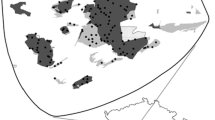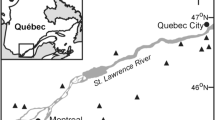Abstract
The effects of fragmentation and edge effects on the floristic composition, richness, diversity and abundance of epixylic bryophytes (growing on decaying wood) were investigated in ten fragments of Atlantic Forest remnants in the Northeast of Brazil. In each fragment, four perpendicular 100 m transects were demarcated. Along these transects, samples of bryophytes growing on decaying wood were collected. The forest fragments were grouped in three size classes (small: <100 ha; medium: 100–500 ha; large: >500 ha). Correlation and multivariate analysis were undertaken between bryophyte flora and fragment metrics (size, form, isolation, altitude variation, nuclear area and secondary vegetation percentage and distance from the edge). A total of 99 species of bryophytes, 52 liverworts and 47 mosses were registered. The statistical results confirming fragment size is an important factor in epixylic community structure. Therefore, composition, richness, diversity and abundance can be better explained by a junction of all studied landscape factors. Bryophyte richness, the percentage of samples with the greatest coverage of decaying wood and shade-tolerant species’ distribution, were not correlated to distance from the forest edge. This suggests that edge effects are not linear or can be detected beyond 100 m from the edge, which is very important for inclusion in future studies.








Similar content being viewed by others
References
Alvarenga LDP, Pôrto KC (2007) Patch size and isolation effects on epiphytic and epiphyllous bryophytes in the fragmented Brazilian Atlantic Forest. Biol Conserv 134:415–427. doi:10.1016/j.biocon.2006.08.031
Arango HG (2005) Bioestatística teórica e computacional. Guanabara Koogan, Rio de Janeiro
Ayres M, Ayres Jr M, Ayres DL, Santos AS (2003) BioEstat 3.0: Aplicações Estatísticas nas áreas das Ciências Biológicas e Médicas. Sociedade Civil Mamirauá, MCT-CNPq, Manaus
Baldwin LK, Bradfield GE (2005) Bryophyte community differences between edge and interior environments in temperate rain-forest fragments of coastal British Columbia. Can J For Res 35:580–592. doi:10.1139/x04-209
Baldwin LK, Bradfield GE (2007) Bryophyte responses to fragmentation in temperate coastal rainforests: a functional group approach. Biol Conserv 136(3):408–422. doi:10.1016/j.biocon.2006.12.006
Buck WR (1998) Pleurocarpous mosses of the West Indies. Mem N Y Bot Gard 1:1–401
Cerqueira R, Brant A, Nascimento MT, Pardini R (2003) Fragmentação: Alguns Conceitos. In: Rambaldi DM, Suaréz de Oliveira DA (eds) Fragmentação de Ecossistemas: Causas Efeitos sobre a Biodiversidade e Recomendações de Políticas Públicas. MMA/SBF, Brasilia, pp 24–40
Conservation International do Brasil, Fundação SOS Mata Atlântica, Fundação Biodiversitas, Instituto de Pesquisas Ecológicas and Secretaria do Meio Ambiente do Estado de São Paulo (2000) Avaliação e Ações Prioritárias para Conservação da Biodiversidade da Mata Atlântica e Campos Sulinos. MMA, Brasília
Costa DP (1999) Epiphytic bryophyte diversity in primary and secondary lowland rainforest in southeastern Brazil. Bryologist 102:320–326. doi:10.2307/3244372
Germano SR, Pôrto KC (1996) Floristic survey of epixylic bryophytes of an area remnant of the Atlantic Forest (Timbaúba, PE, Brazil) 1. Hepaticopsida (except Lejeuneaceae) and Bryopsida. Trop Bryol 12:21–28
Germano SR, Pôrto KC (1997) Ecological analysis of epixylic bryophytes in relation to the decomposition of the substrate (municipality of Timbaúba—Pernambuco, Brazil). Cryptogam Bryol Lichenol 18:143–150
Gignac LD, Dale MRT (2005) Effects of fragment size and habitat heterogeneity on cryptogam diversity in the low-boreal forest of western Canada. Bryologist 108:50–66. doi:10.1639/0007-2745(2005)108[50:EOFSAH]2.0.CO;2
Gradstein SR (1992a) The vanishing tropical rain forest as an environment for bryophytes and lichens. In: Bates W, Farmer AM (eds) Bryophytes and lichens in a changing environment. Clarendon Press, Oxford, pp 234–258
Gradstein SR (1992b) Threatened bryophytes of the neotropical rain forest: a status report. Trop Bryol 6:83–93
Gradstein SR (1994) Lejeuneaceae, Ptychantheae, Brachiolejeuneae. Flora Neotrop Monogr 62:1–225
Gradstein SR, Costa DP (2003) Liverworts and hornworts of Brazil. Mem N Y Bot Gard 87:1–318
Gradstein SR, Churchill SP, Salazar Allen N (2001) Guide to the bryophytes of tropical America. Mem N Y Bot Gard 86:1–577
Harper KA, MacDonald SE, Burton PJ, Chen J, Brosofske KD, Saunders SC, Euskirchen ES, Roberts D, Jaiteh MS, Esseen PA (2005) Edge influence on forest structure and composition in fragmented landscapes. Conserv Biol 19:768–782. doi:10.1111/j.1523-1739.2005.00045.x
Hurlbert SH (1971) The nonconcept of species diversity: a critique and alternative parameters. Ecology 52:577–586. doi:10.2307/1934145
Hylander K (2005) Aspect modifies the magnitude of edge effects on bryophyte growth in boreal forests. J Appl Ecol 42:518–525. doi:10.1111/j.1365-2664.2005.01033.x
Kantvilas G, Jarman SJ (1993) The cryptogamic flora of an isolated rainforest fragment in Tasmania. Bot J Linn Soc 11:211–228
Kapos V (1989) Effects of isolation on the water status of forest patches in the Brazilian Amazon. J Trop Ecol 5:173–185
Laurance WF (1997) Hyper-disturbed parks: edge effects and the ecology of isolated rainforest reserves in tropical Australia. In: Laurance WF, Bierregaard Junior RO (eds) Tropical forest remnants: ecology, management and conservation of fragmented communities. University of Chicago Press, Chicago, pp 71–83
Laurance WF, Delamônica P, Laurance SG, Vasconcelos HL, Lovejoy TE (2000) Rainforest fragmentation kills big trees. Nature 404:836. doi:10.1038/35009032
Mägdefrau K (1982) Life forms of bryophytes. In: Smith AJE (ed) Bryophyte ecology. Chapman & Hall, London, pp 45–57
Moen J, Jonsson BG (2003) Edge effects on liverworts and lichens in forest patches in a mosaic of boreal forest and wetland. Conserv Biol 17:380–388. doi:10.1046/j.1523-1739.2003.00406.x
Murcia C (1995) Edge effects in fragmented forests: implications for conservation. Trends Ecol Evol 10:58–62. doi:10.1016/S0169-5347(00)88977-6
Myers N (1997) Florestas Tropicais e suas Espécies, Sumindo, Sumindo, Sumindo…? In: Wilson EO (ed) Biodiversidade. Nova Fronteira, Rio de Janeiro, pp 89–97
Myers N, Mittermeier RA, Mittermeier CG, Fonseca GAB, Kent J (2000) Biodiversity hotspots for conservation priorities. Nature 403:853–858. doi:10.1038/35002501
Norton DA (2002) Edge effects in a lowland temperate New Zealand rainforest. Doc Science Internal Series 27
Paciencia MLB, Prado J (2005) Effects of forest fragmentation on pteridophyte diversity in a tropical rain forest in Brazil. Plant Ecol 180:87–104. doi:10.1007/s11258-005-3025-x
Pineda E, Halffter G (2004) Species diversity and habitat fragmentation: frogs in a tropical montane landscape in Mexico. Biol Conserv 117:499–508. doi:10.1016/j.biocon.2003.08.009
Pôrto KC (1992) Bryoflores d’une forêt de plaine et d’une forêt d’altitude moyenne dans l’État de Pernambuco (Brésil); Analyse écologique comparative des forêts. Cryptogam Bryol Lichenol 13:187–219
Pôrto KC, Alvarenga LDP, Santos GH (2006) Briófitas. In: Pôrto KC, Almeida-Cortez JS, Tabarelli M (eds) Diversidade Biológica e Conservação da Floresta Atlântica ao Norte do Rio São Francisco. Ministério do Meio Ambiente. Biodiversidade 14, Brasília, pp 123–146
Primack RB, Rodrigues H (2001) Biologia da Conservação. Editora Midiograf, Londrina
Proctor MCF (1979) Structure and eco-physiological adaptation in bryophytes. In: Clarke GCS, Duckett JG (eds) Bryophyte systematics. Academic Press, London, pp 479–509
Ranta P, Blom T, Niemelä J, Joensuu E, Siitonen M (1998) The fragmented Atlantic rain forest of Brazil: size, shape and distribution of forest fragments. Biodivers Conserv 7:385–403. doi:10.1023/A:1008885813543
Richards PW (1984) The ecology of tropical forest bryophytes. In: Schuster RM (ed) New manual of bryology. The Hattori Botanical Laboratory, Nichinan, pp 1233–1270
Ricklefs RM (1993) A Economia da Natureza. Editora Guanabara Koogan S.A., Rio de Janeiro
Sastre-De Jésus I (1992) Estudios Preliminares sobre Comunidades de Briofitas en Troncos en Descomposición en el Bosque Subtropical Lluvioso de Puerto Rico. Trop Bryol 6:181–191
Scariot A, Freitas SR, Neto EM, Nascimento MT, Oliveira LC, Sanaiotti T, Sevilha AC, Villela DM (2003) Vegetação e Flora. In: Rambaldi DM, Oliveira DAS (eds) Fragmentação de Ecossistemas, Causas, efeitos sobre a biodiversidade e recomendações de políticas públicas. Ministério do Meio Ambiente. Biodiversidade 6, Brasília, pp 104–123
Sharp AJ, Crum H, Eckel PM (1994) The moss flora of Mexico. Mem N Y Bot Gard 69:1–1113
Söderstrom L (1998) Modelling the dynamics of bryophyte populations. In: Bates JW, Ashton NW, Duckett JG (eds) Bryology for the twenty-first century. British Bryological Society, pp 321–330
Tabarelli M, Mantovani W, Peres CA (1999) Effects of habitat fragmentation on plant guild structure in the montane Atlantic Forest southeastern Brazil. Biol Conserv 91:119–127. doi:10.1016/S0006-3207(99)00085-3
Tabarelli M, Silva JMC, Gascon C (2004) Forest fragmentation, synergisms and the impoverishment of neotropical forests. Biodivers Conserv 13:1419–1425. doi:10.1023/B:BIOC.0000019398.36045.1b
Tonhasca A Jr (2005) Ecologia e história natural da Mata Atlântica. Editora Interciência, Rio de Janeiro
Turton SM, Freiburger HJ (1997) Edge and aspect effects on the microclimate of a small tropical forest remnant on the Atherton tableland, northeastern Australia. In: Laurance WF, Bierregaard Jr RO (eds) Tropical forest remnants: ecology, management and conservation of fragmented communities. University of Chicago Press, Chicago, pp 45–54
Vána J (1996) Notes on the Jungermaniineae of the world. An Inst Biol Ser Bot 67:99–107
Viana VM, Pinheiro AFV (1998) Conservação da biodiversidade em fragmentos florestais. Ser Tecnica Ipef 12:25–42
Zar JH (1996) Biostatistical analysis, 4th edn. Prentice Hall, NJ
Zartman CE (2003) Habitat fragmentation impacts on epiphyllous bryophyte communities in central Amazonia. Ecology 84:948–954. doi:10.1890/0012-9658(2003)084[0948:HFIOEB]2.0.CO;2
Zartman CE, Nascimento HEM (2006) Are habitat-tracking metacommunities dispersal limited? Inferences from abundance-occupancy patterns of epiphylls in Amazonian forest fragments. Biol Conserv 127:46–54. doi:10.1016/j.biocon.2005.07.012
Acknowledgments
We thank Dr. Denise Pinheiro Costa and Msc. Thaís de Freitas Vaz, from the Rio de Janeiro Botanical Garden and Dr. Olga Yano from the São Paulo Botanical Institute, for help in identifying some bryophyte species; Mateus Dantas de Paula for map creation; Conselho Nacional de Desenvolvimento Científico e Tecnológico—CNPq and Fundação O Boticário de Proteção À Natureza for financial support.
Author information
Authors and Affiliations
Corresponding author
Rights and permissions
About this article
Cite this article
Silva, M.P.P., Pôrto, K.C. Effect of fragmentation on the community structure of epixylic bryophytes in Atlantic Forest remnants in the Northeast of Brazil. Biodivers Conserv 18, 317–337 (2009). https://doi.org/10.1007/s10531-008-9487-0
Received:
Accepted:
Published:
Issue Date:
DOI: https://doi.org/10.1007/s10531-008-9487-0




